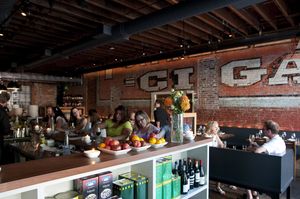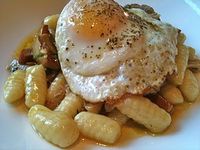Poor Pecorino. It just doesn’t get much respect.
Over the last couple decades, Americans have learned to love Parmesan as a serious cheese and not just something sprinkled out of a Kraft package. But pecorino has had a tougher time shaking off that plebian image.
 Now that seems to be changing. These days Pecorino is showing up as the star at restaurants and in cookbook recipes. A particularly delicious example is the Frisee Salad that I had last week at the new Staple & Fancy Mercantile in Seattle. (MORE about the restaurant below.)
Now that seems to be changing. These days Pecorino is showing up as the star at restaurants and in cookbook recipes. A particularly delicious example is the Frisee Salad that I had last week at the new Staple & Fancy Mercantile in Seattle. (MORE about the restaurant below.)
The composition included lacy frisee, crisp, silky endive, slivers of ripe pear, toasted pistachios and Pecorino Toscana. Held together with a light, citrusy vinaigrette, it was a masterpiece of textures and tastes. (My own version, prepared at home and pictured here, wasn't quite so elegant. But, you get the idea!)
So who knew from Pecorino Toscano? Not I.
However, after a little Googling, I know that Pecorino is the name for a family of hard and semi-hard Italian cheeses that are made from sheep’s milk. There are four main varieties: Pecorino Romano (the best known and usually most pungent), Toscano, Siciliano and Sardo (from Sardinia). The cheeses range from hard and crumbly to soft and shiny, depending on how long they’re aged. All have a distinctive buttery, nutty flavor that works well with nuts and fruits (especially pears), and is ideal for finishing pasta dishes. (It’s less expensive, as well as drier and saltier, than Parmigiano-Reggiano.)
The Toscano that topped the salad at Staple & Fancy was characteristic of that variety. Silky smooth, with a bright, tangy flavor, it brought out the best in the dish’s other components, rather than bullying them.
To be sure, all Pecorino is not created equal. You can still buy Kraft’s Shredded Pecorino Romano in a can. But now you can also buy Pecorino di Fossa (Mario Batali’s Babbo Web site tells the whole fascinating story about this cheese); Pecorino Gran Riserva (which is brushed with olive oil and often served for dessert with a drizzle of honey) ; and Pecorino Umbriaco, the production of which involves grape skins to infuse a pleasant winey flavor. For more info, check out the counters at upscale markets and visit Web sites such as Igourmet.com and Amazon.com.
Back to the Staple & Fancy Mercantile frisee salad. 
Wunderchef Ethan Stowell’s newest eatery is a casual, rustic place with open kitchen, long wooden tables, a high-spirited clientele and a short menu of extraordinary food. Short, that is, unless you order the chef’s fancy, which delivers small portions of nine, ten, eleven or more courses of positively inspired food. (Stowell himself is at the stove here, leaving his other restaurants -- Tavolata, how to Cook a Wolf, and Olives & Anchovies – in capable hands.) The photo here is courtesy of Geoffrey Smith.
You’ve gotta be crazy to forego the Staple & Fancy “family-style supper” – at $45 per person, it's one of the city’s best values. But in case you falter in the decision-making process, the menu provides guidance.
“Thanks for joining us at Staple & Fancy Mercantile. Please feel free to order as much or as little food as you like. And, if you would like to avoid the trouble of ordering altogether, please feel free to hand your menu back to your server and let the kitchen prepare you a family style supper served in four courses for $45 per person. Participation by the entire table is required. We would also like to inform you that you really should do this.”
 When I visited recently, I was on overload after several nights of pigging out at my favorite Seattle eateries. So I opted to order just three courses and was rewarded with the frisee salad and two memorable pasta dishes – rigatoni with luscious pork ragu and fresh marjoram, and a comforting bucatini with guanciale and tomato.
When I visited recently, I was on overload after several nights of pigging out at my favorite Seattle eateries. So I opted to order just three courses and was rewarded with the frisee salad and two memorable pasta dishes – rigatoni with luscious pork ragu and fresh marjoram, and a comforting bucatini with guanciale and tomato.
Unfortunately, in doing so I missed out on many things including this exquisite gnocchi that was enjoyed by Seattle Times restaurant writer Nancy Leson and photographed for her blog.
I can’t wait to go back again and “play by the rules.” Stay tuned.

Comments